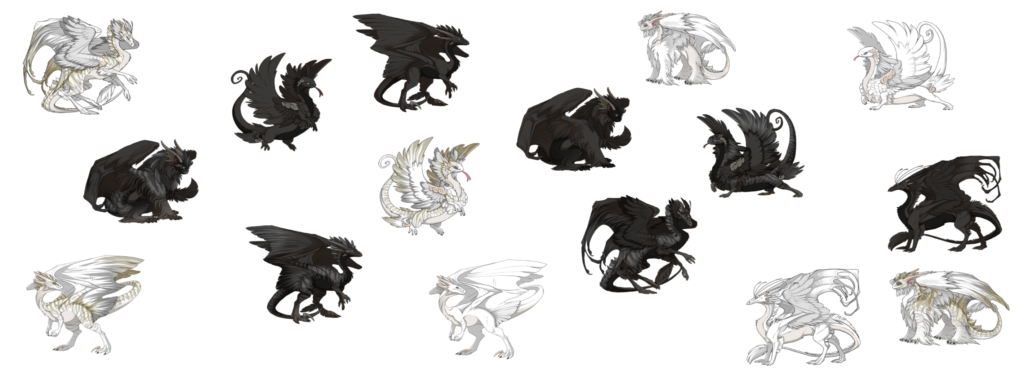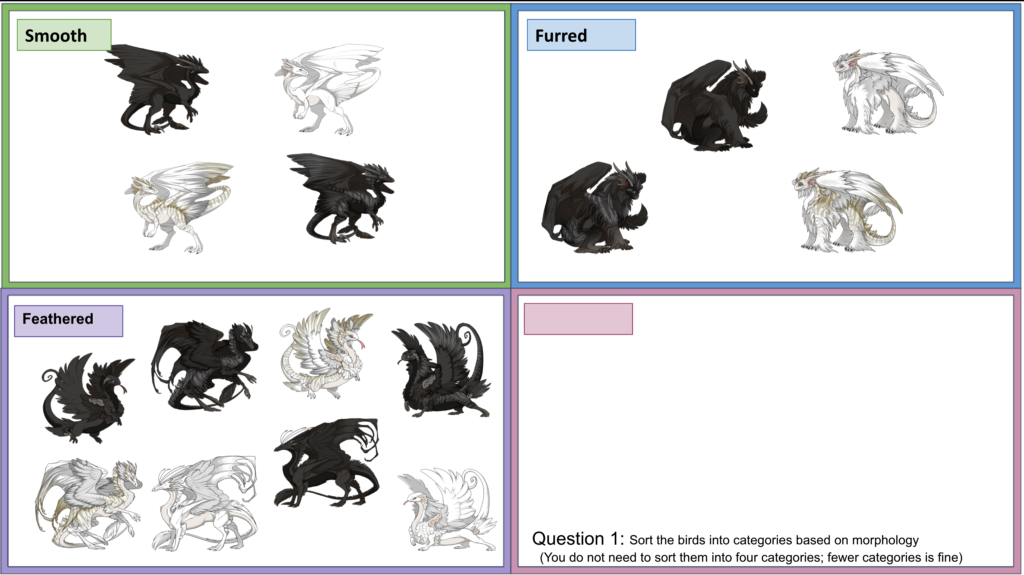The Beak of the Finch
Today we will investigate how resource availability drives evolution by considering 13 species of Galapagos finches.
Research on Daphne Major
There are 13 different species of finch on the Galápagos Islands off the coast of Ecuador. On one of these islands, Daphne Major, biologists Peter and Rosemary Grant have devoted many years to studying four of these bird species.
The Grants have studied the effects of drought and periods of plenty on the finches, and the results of their experiments have had an enormous impact on evolutionary science.
In this activity, you will analyze some of the characteristics of the 13 species of finch found on the Galápagos Islands. Then you will watch a short film, “The Origin of Species: The Beak of the Finch,” about the research conducted by the Grants. The video is broken up into chapters, with discussion questions after each section.
Based on the information presented in the film and your own observations, you will construct an argument and make predictions about the role of natural selection on the evolution of finch populations.
Grouping by Morphology
Grouping species according to shared characteristics can provide clues to how they have evolved. Morphological characters – characteristics of structure and form, such as size, shape, color – are often used for this purpose.
Morphological Groups
- Examine the images of thirteen different species of Galápagos finches found on the last pages of the worksheet.
- Based on their morphological characteristics, come up with a grouping system for the finches.
- You can use whatever characteristics make the most sense to you: size, shape, color, etc.
- Create appropriate labels for the categories
- Sort each finch into the appropriate category.




- List the labels you assigned to each group, and list the species that fall into each category.
- Explain why you decided to group them in this way.
Film: Part I
Watch the first segment of the film, then answer the questions that follow.
- What do the different beaks tell us about the different finch species?
- What evidence did scientists use to determine that the 13 species of finches on the Galápagos arose from a single common ancestor?
- What was an alternative explanation, and how did the scientists discount it?
- Why was the scientific conclusion of common ancestry important for understanding the effects of natural selection on these bird species?
Revising Morphological Groups
Return to your finch groupings. Using information and evidence from the film, revise your groupings (if necessary). If you are happy with your original groups, you do not need to adjust them.
- Regarding the way you grouped the birds:
- What did you change? (If you didn’t make any changes, explain why)
- What evidence from the film convinced you to make the change?
- What do the different groups of finches that you created represent?
Film: Part II
Watch the second part of the film and answer the questions that follow.
- Describe the beak sizes of the medium ground finch population (species #12 in the finch cards).
- How did the population of medium ground finches on the island of Daphne Major change as a result of environmental changes?
- After watching the segment, create a column graph that predicts what will happen to the beak sizes of birds in the population of medium ground finches before and after the drought.
- Your graph should indicate the number of medium ground finches with each of four different beak sizes (from smallest to largest) before and after the drought.
- (Hint: create two bars for each category of beak size, one representing the populations before the drought, and one representing the populations after the drought).
- Your graph should indicate the number of medium ground finches with each of four different beak sizes (from smallest to largest) before and after the drought.
Film: Part III
Watch the third segment of the film and answer the questions that follow.
- How did your graph compare to the graph in the film?
- If your graph was close to the one in the film, what part of your thinking was the same as that of the scientists in the film?
- If your graph was not similar, what evidence did you not consider?
- Why did the drought have such an impact on the medium ground finch population?
- Prediction: What was the response of Peter and Rosemary Grant to the dramatic change in the distribution of beak sizes in just one generation of birds?
- If the drought had continued longer, what would you expect your beak graph to look like?
Film: Part IV
Watch the final segment of the film and answer the questions that follow.
- Based on the evidence in the film, construct an explanation for how one ancestral finch population give rise to 13 species, each with different characteristics.
- Discuss how the process of evolution primarily results from competition for limited resources (such as water, shelter, and mates) and differences in the abilities of individuals in a population to survive and reproduce in that environment.
- Make sure to include ideas about natural selection in your explanation.
- Adapted from an activity by the Howard Hughes Medical Institute: “The Origin of Species: The Beak of the Finch.”
- Primary Literature
- Grant, Peter R., and B. Rosemary Grant. How and Why Species Multiply. Princeton, New Jersey: Princeton University Press, 2008.
- Weiner, Jonathan. The Beak of the Finch. New York: Alfred A. Knopf, Inc., 1994.
Natural Selection Scenarios
Select one of the scenarios below, and create a short presentation using the Google Slide template here: https://docs.google.com/presentation/d/1vFcvHN4wbr01PHaThvAc7j3M87lgUOvvKh0rQbBrwyg/edit?usp=sharing
- Scenario 1: Mycobacterium tuberculosis, the bacteria that causes the disease tuberculosis, was once easily killed in infected individuals when they were treated with antibiotic medications. In recent years however, strains of M. tuberculosis that are resistant to antibiotic treatment have become prevalent in some human populations.
- Scenario 2: Giant pandas strip the low nutrient leaves off of bamboo stems before they feed on the pulpy shoot. They strip these leaves by running the shoot between their paw and what appears to be a “thumb” that extends from the lower part of the paw. However, this structure is not a thumb like ours; that is, it is not made up of finger bones. Instead, it is an enlarged version of one of the bones of the wrist and is immobile.
- Scenario 3: Crayfish that live in deep caves appear very similar to crayfish that live in the open. However, cave crayfish are blind; although they produce eyestalks (places where eyes normally sit) that are identical to the eye stalks of open-living crayfish, except that they do not have functional eyes.
- Scenario 4: The sickle-cell allele is more common in regions where malaria is a common disease. Individuals with two copies of the sickle-cell allele have sickle-cell disease and often die at a young age. However, individuals with one copy of the sickle-cell allele and one wildtype allele do not get severe sickle-cell symptoms. These heterozygotes also have a lower rate of getting malaria than those with only wildtype alleles.
- Scenario 5: There are no warblers on the Galapagos Islands, but there are finches that act like warblers. On the mainland, finches are primarily seed-eating birds, whereas warblers tend to specialize on flying insects. Warbler finches on the Galapagos Islands eat insects. Mainland finches have broad short bills for cracking seeds, whereas mainland warblers have longer, thin bills for catching insects. Warbler finches on the Galapagos Islands have thinner bills than sedd- eating finches, their closest relatives.
- Scenario 6: Photosynthesis is the process that converts sun energy into chemical energy. The structure inside of plant cells that performs photosynthesis is called a chloroplast. Chloroplasts appear very similar to certain species of bacteria that can do photosynthesis. Chloroplasts appear to have evolved from bacteria that were engulfed, but not digested, by other cells. Chloroplasts cannot survive outside of their host cell.